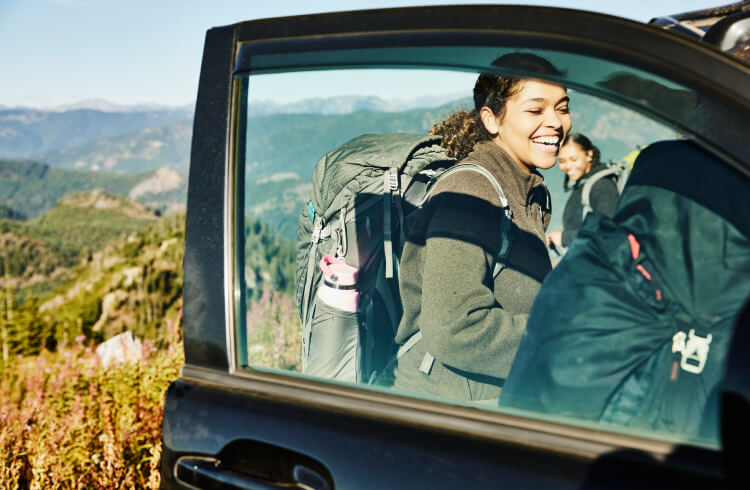How to Look After a Car When You’re on a Road Trip
These simple car-maintenance skills will keep your trip, and your car, on the right track.
 Photo © Getty Images/Thomas Barwick
Photo © Getty Images/Thomas Barwick
Buying a cheap, used car and heading off into the sunset is as American as Ford. Before you commit, get the vehicle inspected by a mechanic to make sure it has no major issues. Here are some simple skills you should learn to keep you rolling.
How to change a tire
In many ways, changing a tire is one of the most dangerous things you can do. Watch out for traffic.
Get off the road as much as possible, while keeping the car on a level, firm surface. Never change a tire on a hill or slope. Place the car in park and engage the emergency brake. Ideally, you’ll have some emergency triangles like these to warn other motorists.
Most cars come with a jack stored somewhere in the rear near the spare tire. A jack typically has two, detachable parts, a crank and the jack itself. The crank may have a socket on one end or the socket may be a third, separate tool. It may also have a flat end for prying off the hubcap if needed.
Check the car’s manual to see where the jack needs to contact the frame. No manual? Google it. Get it wrong and you risk having the jack fail.
Chock the tires you aren’t changing with rocks to prevent the vehicle from rolling. Use the socket to “break” the tension (loosen) on the lug nuts on the damaged tire, but do not remove them. Do this before you jack the car up.
Raise the jack until the damaged tire can spin freely. Use the socket to remove the lug nuts entirely.
Remove the bad tire. Place the spare onto the bolts and tighten the nuts by hand. Use the socket to fully tighten them in a star pattern. Tighten a nut, then the one opposite that nut, moving around until they’re all tight. That keeps the wheel properly aligned.
Your spare is likely a flimsy “donut” that cannot handle highway speeds. Get the damaged tire fixed pronto.
How to jump-start a car
A dead battery is the worst but it’s easy to fix. Keep an eye on it, though. A depleted battery could be a sign of a failing alternator or a failing battery. Take your vehicle to an auto parts store like O’Reilly’s or Napa. They’ll test it for free.
- Never let the jumper cable clamps touch each other
- Never bridge a battery’s terminal posts.
Here are the steps:
- Make sure all battery posts are free of corrosion. A wire brush works best
- Turn the good car off and connect the positive clamp (generally red or not black) to the positive post on the good car’s battery. Make sure the negative clamps (always black) aren’t touching any metal
- Connect the positive clamp to the positive post on the bad battery
- Connect the negative clamp to the negative post on the good battery
- Connect the negative clamp to a bare piece of metal on the dead car. The owner’s manual may suggest the best spot for this.
- Turn the good car on and let it run for five minutes
- Try to start the dead car. No luck? Make sure the clamps are securely connected
- Once the dead car starts, remove the clamps in reverse order, being careful to not let them touch.
If you plan to be far from other vehicles, carry a portable battery like this one designed specifically for jumping car batteries.
Check the car’s fluids
Vehicles, like us, need to stay hydrated. It’s a good idea to check the oil and coolant frequently, especially if you’re driving an older vehicle.
Oil
Release the car’s hood. A latch on the hood itself keeps it from opening all the way. Reach under the hood to release that latch and open the hood completely.
Find the dipstick. It’s usually yellow or orange and will have an oil symbol on it or nearby.
Pull the dipstick all the way out. Wipe it clean with a rag and reinsert the dipstick into the sheath.
Remove it again and note how far up the dipstick the oil reaches. The dipstick should have two lines. If it’s below the bottom line, add a quart of oil through the oil port. That port should be labeled and have an oil can symbol. Use the weight of oil recommended in the manual, typically something like 10w40.
Check the dipstick again after several minutes. The oil does not need to reach the top mark but be between the two marks.
Do not overfill!
Coolant
Ever seen a car on the side of the road with steam coming out from under the hood? Don’t be that person. Check your coolant.
Make sure the engine is completely cool. Open the hood and look for the coolant reservoir. It will most likely be clear with a maximum fill line.
Check your manual to see the type of coolant you should use, typically a 50/50 mix of water and antifreeze. Fill the reservoir to the fill line. Don’t overfill.
If the coolant has particles in it and looks oily or rusty, get it checked by a mechanic.
How to fit snow chains
In many states, if you’re traveling over mountain passes in winter you must carry chains by law. Putting them on your vehicle is a hassle but not as bad as getting stuck or in a wreck.
It’s critical you get chains that fit your tires. An auto parts store or tire salesperson can help.
If your vehicle is front-wheel drive, put the chains on the front wheels. Rear wheel? Put them on the rear. For all-wheel-drive vehicles, check your owner’s manual and do what’s recommended.
Chains always come with instructions so follow yours. The first step: make sure your chains are not twisted but hang freely.
Lay the chains out behind the tire under the car.
Bring both ends of the chain up to the top of the tire and clip them together.
Arrange the chains so the center falls across the middle of the tire. A hook on the chain should connect to a link opposite the hook to secure the chain across the outside of the tire.
The bottom of the chains typically has a tightener denoted by a different color chain, often red. To tighten, thread one end of the red chain through a guiding mechanism and pull it tight. Thread the loose end of the red chain through a loop opposite the guide and pull it tight. Fasten the loose end of the red chain to a link along the side of the tire.
Repeat this on the other side.
Drive forward a short distance, retighten the chains and drive off, slowly. If you hear the chains smacking your vehicle, stop and tighten them.



No Comments